Section 4.6 Point-Slope Form
In Section 4.5, we learned that a linear equation can be written in slope-intercept form, \(y=mx+b\text{.}\) This section covers an alternative that can often be more useful depending on the application: point-slope form.
Subsection 4.6.1 Point-Slope Motivation and Definition
Starting in 1990, the population of the United States has been growing by about \(2.865\) million per year. Also, back in 1990, the population was \(253\) million. Since the rate of growth has been roughly constant, a linear model is appropriate. Let's try to write an equation to model this.
We consider using slope-intercept form, but we would need to know the \(y\)-intercept, and nothing in the background tells us that. We'd need to know the population of the United States in the year 0, before there even was a United States.
We could do some side work to calculate the \(y\)-intercept, but let's try something else. Here are some things we know:
The slope equation is \(m=\frac{y_2-y_1}{x_2-x_1}\text{.}\)
The slope is \(m=2.865\) (million per year).
One point on the line is \((1990,253)\text{,}\) because in 1990, the population was \(253\) million.
If we use the generic \((x,y)\) to represent a point somewhere on this line, then the rate of change between \((1990,253)\) and \((x,y)\) has to be \(2.865\text{.}\) So
There is good reason 1 to want to isolate \(y\) in this equation:
This is a good place to stop. We have isolated \(y\text{,}\) and three meaningful numbers appear in the population: the rate of growth, a certain year, and the population in that year. This is a specific example of point-slope form. Before we look deeper at point-slope form, let's continue reducing the line equation into slope-intercept form.
One concern with slope-intercept form is that it uses the \(y\)-intercept, which might be somewhat meaningless in the context of an application. For example, here we have found that the \(y\)-intercept is at \((0,-5448.35)\text{,}\) but what practical use is that? It's nonsense to say that in the year 0, the population of the United States was \(-5448.35\) million. It doesn't make sense to have a negative population. It doesn't make sense to talk about the United States population before there even was a United States. And it doesn't make sense to use this model for years earlier than 1990 because the background information says clearly that the rate of change we have applies to years 1990 and later.
For all these reasons, we prefer the equation when it was in the form
Definition 4.6.1. Point-Slope Form.
When \(x\) and \(y\) have a linear relationship where \(m\) is the slope and \((x_0,y_0)\) is some specific point that the line passes through, one equation for this relationship is
and this equation is called the point-slope form of the line. It is called this because the slope and one point on the line are immediately discernible from the numbers in the equation.
Remark 4.6.3. Alternative Point-Slope Form.
It is also common to define point-slope form as
by subtracting \(y_0\) from each side. Some exercises may appear using this form.
Checkpoint 4.6.4.
In Checkpoint 4.6.4, the solution explains that each of the following are acceptable equations for the same line:
The first uses \((3,2)\) as a point on the line, and the second uses \((2,-1)\text{.}\) Are those two equations really equivalent? Let's distribute and simplify each of them to get slope-intercept form.
So, yes. It didn't matter which point we used to write a point-slope equation. We get different-looking equations that still represent the same line.
Point-slope form is preferable when we know a line's slope and a point on it, but we don't know the \(y\)-intercept.
Example 4.6.5.
A spa chain has been losing customers at a roughly constant rate since the year 2010. In 2013, it had \(2{,}975\) customers; in 2016, it had \(2{,}585\) customers. Management estimated that the company will go out of business once its customer base decreases to \(1{,}800\text{.}\) If this trend continues, when will the company close?
The given information tells us two points on the line: \((2013,2975)\) and \((2016,2585)\text{.}\) The slope formula will give us the slope. After labeling those two points as \((\overset{x_1}{2013},\overset{y_1}{2975})\) and \((\overset{x_2}{2016},\overset{y_2}{2585})\text{,}\) we have:
And considering units, this means they are losing \(130\) customers per year.
Let's note that we could try to make an equation for this line in slope-intercept form, but then we would need to calculate the \(y\)-intercept, which in context would correspond to the number of customers in year \(0\text{.}\) We could do it, but we'd be working with numbers that have no real-world meaning in this context.
For point-slope form, since we calculated the slope, we know at least this much:
Now we can pick one of those two given points, say \((2013,2975)\text{,}\) and get the equation
Note that all three numbers in this equation have meaning in the context of the spa chain.
We're ready to answer the question about when the chain might go out of business. Substitute \(y\) in the equation with \(1800\) and solve for \(x\text{,}\) and we will get the answer we seek.
And so we find that at this rate, the company is headed toward a collapse in 2022.
Shown is a graph that represents the scenario. Note that to make a graph of \(y=-130(x-2013)+2975\text{,}\) we must first find the point \((2013,2975)\) and from there use the slope of \(-130\) to draw the line.
Checkpoint 4.6.7.
Subsection 4.6.2 Using Two Points to Build a Linear Equation
Since two points can determine a line's location, we can calculate a line's equation using just the coordinates from any two points it passes through.
Example 4.6.8.
A line passes through \((-6,0)\) and \((9,-10)\text{.}\) Find this line's equation in both point-slope and slope-intercept form.
We will use the slope formula to find the slope first. After labeling those two points as \((\overset{x_1}{-6},\overset{y_1}{0}) \text{ and } (\overset{x_2}{9},\overset{y_2}{-10})\text{,}\) we have:
The point-slope equation is \(y=-\frac{2}{3}(x-x_0)+y_0\text{.}\) Next, we will use \((9,-10)\) and substitute \(x_0\) with \(9\) and \(y_0\) with \(-10\text{,}\) and we have:
Next, we will change the point-slope equation into slope-intercept form:
Remark 4.6.9.
Note that many other resources use the alternate point-slope form to write their equations. Those equations will always be equivalent to those created using our point-slope form. In Example 4.6.8, we found the point-slope form \(y=-\frac{2}{3}(x-9)-10\text{.}\) The alternate point-slope form equation 2 would have given us \(y+10=-\frac{2}{3}(x-9)\text{.}\) If you solve this equation for \(y\) and simplify, you should still get \(y=-\frac{2}{3}x-4\text{,}\) as we did earlier.
Checkpoint 4.6.10.
Subsection 4.6.3 More on Point-Slope Form
We can tell a lot about a linear equation now that we have learned both slope-intercept form and point-slope form. For example, we can know that \(y=4x+2\) is in slope-intercept form because it looks like \(y=mx+b\text{.}\) It will graph as a line with slope \(4\) and vertical intercept \((0,2)\text{.}\) Likewise, we know that the equation \(y=-5(x-3)+2\) is in point-slope form because it looks like \(y=m(x-x_0)+y_0\text{.}\) It will graph as a line that has slope \(-5\) and will pass through the point \((3,2)\text{.}\)
Example 4.6.11.
For the equations below, state whether they are in slope-intercept form or point-slope form. Then identify the slope of the line and at least one point that the line will pass through.
\(\displaystyle y=-3x+2\)
\(\displaystyle y=9(x+1)-6\)
\(\displaystyle y=5-x\)
\(\displaystyle y=-\frac{12}{5}(x-9)+1\)
The equation \(y=-3x+2\) is in slope-intercept form. The slope is \(-3\) and the vertical intercept is \((0,2)\text{.}\)
The equation \(y=9(x+1)-6\) is in point-slope form. The slope is \(9\) and the line passes through the point \((-1,-6)\text{.}\)
The equation \(y=5-x\) is almost in slope-intercept form. If we rearrange the right hand side to be \(y=-x+5\text{,}\) we can see that the slope is \(-1\) and the vertical intercept is \((0,5)\text{.}\)
The equation \(y=-\frac{12}{5}(x-9)+1\) is in point-slope form. The slope is \(-\frac{12}{5}\) and the line passes through the point \((9,1)\text{.}\)
Remark 4.6.12.
Again, we should note that the alternate point-slope form can be used to identify equations. For example, the equation \(y+10=-\frac{2}{3}(x-9)\) matches the alternate point-slope form equation 3 with slope \(-\frac{2}{3}\) and the line passes through the point \((9,-10)\text{.}\) Note that both coordinates are the opposite of what they appear to be in the equation with this form.
Example 4.6.13.
Consider the graph in Figure 4.6.14.
Find three equations that describe the line shown written in point-slope form. Three integer-valued points are shown for convenience.
Determine the slope-intercept form of the equation of this line.
-
To write any of the equations representing this line in point-slope form, we must first find the slope of the line and we can use the slope formula to do so. We will arbitrarily choose \((0,30)\) and \((-5,42)\) as the two points. Inputting these points into the slope formula yields:
\begin{align*} m\amp=\frac{y_2-y_1}{x_2-x_1}\\ \amp=\frac{\substitute{42}-\substitute{30}}{\substitute{-5}-\substitute{0}}\\ \amp=\frac{12}{-5}\\ \amp=-\frac{12}{5} \end{align*}Thus, the slope of the line is \(-\frac{12}{5}\text{.}\)
Next, we need to write an equation in point-slope form based on each point shown. Using the point \((0,30)\text{,}\) we have:
\begin{equation*} y=-\frac{12}{5}(x-0)+30 \end{equation*}(This simplifies to \(y=-\frac{12}{5}x+30\text{.}\))
The next point is \((20,-18)\text{.}\) Using this point, we can write an equation for this line as:
\begin{equation*} y=-\frac{12}{5}(x-20)-18 \end{equation*}Finally, we can also use the point \((-5,42)\) to write an equation for this line:
\begin{equation*} y=-\frac{12}{5}(x-(-5))+42 \end{equation*}which can also be written as:
\begin{equation*} y=-\frac{12}{5}(x+5)+42 \end{equation*} As \((0,30)\) is the vertical intercept, we can write the equation of this line in slope-intercept form as \(y=-\frac{12}{5}x+30\text{.}\) It's important to note that each of the equations that were written in point-slope form simplify to this, making all four equations equivalent.
Exercises 4.6.4 Exercises
Review and Warmup
1.
Evaluate \({-6A+8c}\) for \(A = 4\) and \(c = -7\text{.}\)
2.
Evaluate \({7B-8C}\) for \(B = -8\) and \(C = 8\text{.}\)
3.
Evaluate
for \(x_1 = 13\text{,}\) \(x_2 = 6\text{,}\) \(y_1 = 2\text{,}\) and \(y_2 = 4\text{:}\)
4.
Evaluate
for \(x_1 = 17\text{,}\) \(x_2 = -8\text{,}\) \(y_1 = 19\text{,}\) and \(y_2 = -7\text{:}\)
Point-Slope Form
5.
A line’s equation is given in point-slope form:
\({y}={5\!\left(x-5\right)+28}\)
This line’s slope is .
A point on this line that is apparent from the given equation is .
6.
A line’s equation is given in point-slope form:
\({y}={2\!\left(x-1\right)+5}\)
This line’s slope is .
A point on this line that is apparent from the given equation is .
7.
A line’s equation is given in point-slope form:
\({y}={-2\!\left(x+2\right)+5}\)
This line’s slope is .
A point on this line that is apparent from the given equation is .
8.
A line’s equation is given in point-slope form:
\({y}={-3\!\left(x+4\right)+7}\)
This line’s slope is .
A point on this line that is apparent from the given equation is .
9.
A line’s equation is given in point-slope form:
\(\displaystyle{ {y}={\left(-\frac{5}{6}\right)\!\left(x+12\right)+15} }\)
This line’s slope is .
A point on this line that is apparent from the given equation is .
10.
A line’s equation is given in point-slope form:
\(\displaystyle{ {y}={\frac{6}{5}\!\left(x+10\right) - 8} }\)
This line’s slope is .
A point on this line that is apparent from the given equation is .
11.
A line passes through the points \((5,29)\) and \((2,17)\text{.}\) Find this line’s equation in point-slope form.
or
12.
A line passes through the points \((2,16)\) and \((1,11)\text{.}\) Find this line’s equation in point-slope form.
or
13.
A line passes through the points \((2,-8)\) and \((4,-18)\text{.}\) Find this line’s equation in point-slope form.
or
14.
A line passes through the points \((-4,17)\) and \((1,7)\text{.}\) Find this line’s equation in point-slope form.
or
15.
A line passes through the points \((-10,{-3})\) and \((0,{1})\text{.}\) Find this line’s equation in point-slope form.
or
16.
A line passes through the points \((6,{8})\) and \((-6,{-10})\text{.}\) Find this line’s equation in point-slope form.
or
17.
A line’s slope is \(3\text{.}\) The line passes through the point \((2,10)\text{.}\) Find an equation for this line in both point-slope and slope-intercept form.
An equation for this line in point-slope form is: .
An equation for this line in slope-intercept form is: .
18.
A line’s slope is \(3\text{.}\) The line passes through the point \((4,15)\text{.}\) Find an equation for this line in both point-slope and slope-intercept form.
An equation for this line in point-slope form is: .
An equation for this line in slope-intercept form is: .
19.
A line’s slope is \(-3\text{.}\) The line passes through the point \((-3,4)\text{.}\) Find an equation for this line in both point-slope and slope-intercept form.
An equation for this line in point-slope form is: .
An equation for this line in slope-intercept form is: .
20.
A line’s slope is \(-3\text{.}\) The line passes through the point \((1,0)\text{.}\) Find an equation for this line in both point-slope and slope-intercept form.
An equation for this line in point-slope form is: .
An equation for this line in slope-intercept form is: .
21.
A line’s slope is \(1\text{.}\) The line passes through the point \((-1,2)\text{.}\) Find an equation for this line in both point-slope and slope-intercept form.
An equation for this line in point-slope form is: .
An equation for this line in slope-intercept form is: .
22.
A line’s slope is \(1\text{.}\) The line passes through the point \((-5,0)\text{.}\) Find an equation for this line in both point-slope and slope-intercept form.
An equation for this line in point-slope form is: .
An equation for this line in slope-intercept form is: .
23.
A line’s slope is \(-1\text{.}\) The line passes through the point \((2,-7)\text{.}\) Find an equation for this line in both point-slope and slope-intercept form.
An equation for this line in point-slope form is: .
An equation for this line in slope-intercept form is: .
24.
A line’s slope is \(-1\text{.}\) The line passes through the point \((-2,-2)\text{.}\) Find an equation for this line in both point-slope and slope-intercept form.
An equation for this line in point-slope form is: .
An equation for this line in slope-intercept form is: .
25.
A line’s slope is \({{\frac{3}{2}}}\text{.}\) The line passes through the point \((-2,{-1})\text{.}\) Find an equation for this line in both point-slope and slope-intercept form.
An equation for this line in point-slope form is: .
An equation for this line in slope-intercept form is: .
26.
A line’s slope is \({{\frac{4}{7}}}\text{.}\) The line passes through the point \((-14,{-12})\text{.}\) Find an equation for this line in both point-slope and slope-intercept form.
An equation for this line in point-slope form is: .
An equation for this line in slope-intercept form is: .
27.
A line’s slope is \({-{\frac{5}{4}}}\text{.}\) The line passes through the point \((12,{-14})\text{.}\) Find an equation for this line in both point-slope and slope-intercept form.
An equation for this line in point-slope form is: .
An equation for this line in slope-intercept form is: .
28.
A line’s slope is \({-{\frac{6}{7}}}\text{.}\) The line passes through the point \((14,{-14})\text{.}\) Find an equation for this line in both point-slope and slope-intercept form.
An equation for this line in point-slope form is: .
An equation for this line in slope-intercept form is: .
Point-Slope and Slope-Intercept
29.
Change this equation from point-slope form to slope-intercept form.
\({y}={4\!\left(x+1\right)-3}\)
In slope-intercept form:
30.
Change this equation from point-slope form to slope-intercept form.
\({y}={5\!\left(x-3\right)+12}\)
In slope-intercept form:
31.
Change this equation from point-slope form to slope-intercept form.
\({y}={-2\!\left(x+3\right)+11}\)
In slope-intercept form:
32.
Change this equation from point-slope form to slope-intercept form.
\({y}={-5\!\left(x-1\right)-4}\)
In slope-intercept form:
33.
Change this equation from point-slope form to slope-intercept form.
\(\displaystyle{ {y}={{\frac{2}{3}}\!\left(x+3\right)-7} }\)
In slope-intercept form:
34.
Change this equation from point-slope form to slope-intercept form.
\(\displaystyle{ {y}={{\frac{3}{8}}\!\left(x+16\right)-11} }\)
In slope-intercept form:
35.
Change this equation from point-slope form to slope-intercept form.
\(\displaystyle{ {y}={-{\frac{4}{9}}\!\left(x+18\right)+11} }\)
In slope-intercept form:
36.
Change this equation from point-slope form to slope-intercept form.
\(\displaystyle{ {y}={-{\frac{5}{3}}\!\left(x+6\right)+8} }\)
In slope-intercept form:
Point-Slope Form and Graphs
37.
Determine the point-slope form of the linear equation from its graph.
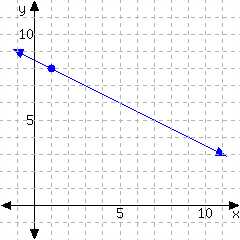
38.
Determine the point-slope form of the linear equation from its graph.
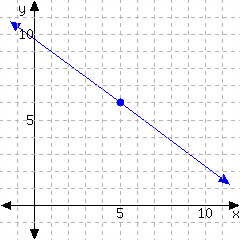
39.
Determine the point-slope form of the linear equation from its graph.
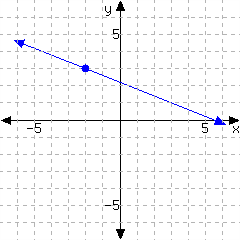
40.
Determine the point-slope form of the linear equation from its graph.
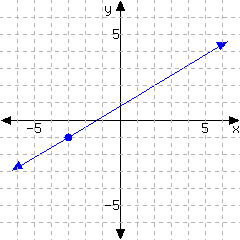
41.
Determine the point-slope form of the linear equation from its graph.

42.
Determine the point-slope form of the linear equation from its graph.
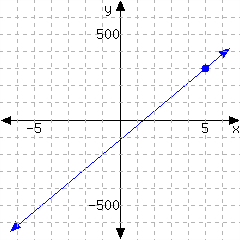
43.
Determine the point-slope form of the linear equation from its graph.
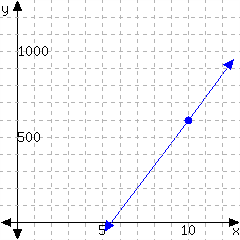
44.
Determine the point-slope form of the linear equation from its graph.
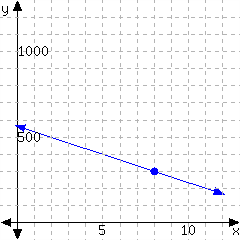
45.
Determine the point-slope form of the linear equation from its graph.
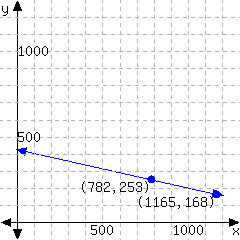
46.
Determine the point-slope form of the linear equation from its graph.
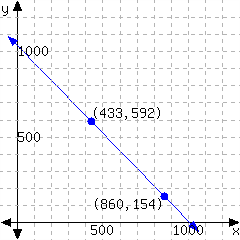
47.
Determine the point-slope form of the linear equation from its graph.
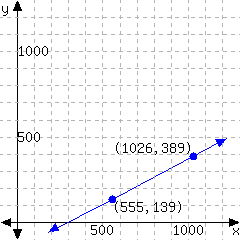
48.
Determine the point-slope form of the linear equation from its graph.
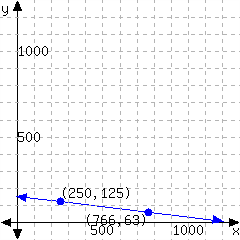
49.
Graph the linear equation \(y=-\frac{8}{3}(x-4)-5\) by identifying the slope and one point on this line.
50.
Graph the linear equation \(y=\frac{5}{7}(x+3)+2\) by identifying the slope and one point on this line.
51.
Graph the linear equation \(y=\frac{3}{4}(x+2)+1\) by identifying the slope and one point on this line.
52.
Graph the linear equation \(y=-\frac{5}{2}(x-1)-5\) by identifying the slope and one point on this line.
53.
Graph the linear equation \(y=-3(x-9)+4\) by identifying the slope and one point on this line.
54.
Graph the linear equation \(y=7(x+3)-10\) by identifying the slope and one point on this line.
55.
Graph the linear equation \(y=8(x+12)-20\) by identifying the slope and one point on this line.
56.
Graph the linear equation \(y=-5(x-20)-70\) by identifying the slope and one point on this line.
Applications
57.
By your cell phone contract, you pay a monthly fee plus \({\$0.07}\) for each minute you spend on the phone. In one month, you spent \(280\) minutes over the phone, and had a bill totaling \({\$35.60}\text{.}\)
Let \(x\) be the number of minutes you spend on the phone in a month, and let \(y\) be your total cell phone bill for that month, in dollars. Use a linear equation to model your monthly bill based on the number of minutes you spend on the phone.
A point-slope equation to model this is .
If you spend \(110\) minutes on the phone in a month, you would be billed .
If your bill was \({\$46.10}\) one month, you must have spent minutes on the phone in that month.
58.
A company set aside a certain amount of money in the year 2000. The company spent exactly \({\$20{,}000}\) from that fund each year on perks for its employees. In \(2002\text{,}\) there was still \({\$683{,}000}\) left in the fund.
Let \(x\) be the number of years since 2000, and let \(y\) be the amount of money, in dollars, left in the fund that year. Use a linear equation to model the amount of money left in the fund after so many years.
A point-slope equation to model this is .
In the year \(2011\text{,}\) there was left in the fund.
In the year , the fund will be empty.
59.
A biologist has been observing a tree’s height. This type of tree typically grows by \(0.12\) feet each month. Thirteen months into the observation, the tree was \(20.26\) feet tall.
Let \(x\) be the number of months passed since the observations started, and let \(y\) be the tree’s height at that time, in feet. Use a linear equation to model the tree’s height as the number of months pass.
A point-slope equation to model this is .
\(30\) months after the observations started, the tree would be feet in height.
months after the observation started, the tree would be \(24.94\) feet tall.
60.
Scientists are conducting an experiment with a gas in a sealed container. The mass of the gas is measured, and the scientists realize that the gas is leaking over time in a linear way. Each minute, they lose \(6.5\) grams. Ten minutes since the experiment started, the remaining gas had a mass of \(208\) grams.
Let \(x\) be the number of minutes that have passed since the experiment started, and let \(y\) be the mass of the gas in grams at that moment. Use a linear equation to model the weight of the gas over time.
A point-slope equation to model this is .
\(40\) minutes after the experiment started, there would be grams of gas left.
If a linear model continues to be accurate, minutes since the experiment started, all gas in the container will be gone.
61.
A company set aside a certain amount of money in the year 2000. The company spent exactly the same amount from that fund each year on perks for its employees. In \(2003\text{,}\) there was still \({\$616{,}000}\) left in the fund. In \(2007\text{,}\) there was \({\$496{,}000}\) left.
Let \(x\) be the number of years since 2000, and let \(y\) be the amount of money, in dollars, left in the fund that year. Use a linear equation to model the amount of money left in the fund after so many years.
A point-slope equation to model this is .
In the year \(2011\text{,}\) there was left in the fund.
In the year , the fund will be empty.
62.
By your cell phone contract, you pay a monthly fee plus some money for each minute you use the phone during the month. In one month, you spent \(290\) minutes on the phone, and paid \({\$29.15}\text{.}\) In another month, you spent \(350\) minutes on the phone, and paid \({\$31.25}\text{.}\)
Let \(x\) be the number of minutes you talk over the phone in a month, and let \(y\) be your cell phone bill, in dollars, for that month. Use a linear equation to model your monthly bill based on the number of minutes you talk over the phone.
A point-slope equation to model this is .
If you spent \(200\) minutes over the phone in a month, you would pay .
If in a month, you paid \({\$35.80}\) of cell phone bill, you must have spent minutes on the phone in that month.
63.
Scientists are conducting an experiment with a gas in a sealed container. The mass of the gas is measured, and the scientists realize that the gas is leaking over time in a linear way.
Six minutes since the experiment started, the gas had a mass of \(244\) grams.
Twelve minutes since the experiment started, the gas had a mass of \(207.4\) grams.
Let \(x\) be the number of minutes that have passed since the experiment started, and let \(y\) be the mass of the gas in grams at that moment. Use a linear equation to model the weight of the gas over time.
A point-slope equation to model this is .
\(40\) minutes after the experiment started, there would be grams of gas left.
If a linear model continues to be accurate, minutes since the experiment started, all gas in the container will be gone.
